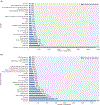Outcomes of the Halliburton Loophole: Chemicals regulated by the Safe Drinking Water Act in US fracking disclosures, 2014-2021
- PMID: 36368552
- PMCID: PMC10187986
- DOI: 10.1016/j.envpol.2022.120552
Outcomes of the Halliburton Loophole: Chemicals regulated by the Safe Drinking Water Act in US fracking disclosures, 2014-2021
Abstract
Hydraulic fracturing (fracking) has enabled the United States to lead the world in gas and oil production over the past decade; 17.6 million Americans now live within a mile of an oil or gas well (Czolowski et al., 2017). This major expansion in fossil fuel production is possible in part due to the 2005 Energy Policy Act and its "Halliburton Loophole," which exempts fracking activity from regulation under the Safe Drinking Water Act (SDWA). To begin quantifying the environmental and economic impacts of this loophole, this study undertakes an aggregate analysis of chemicals that would otherwise be regulated by SDWA within FracFocus, an industry-sponsored fracking disclosure database. This paper quantifies the total disclosures and total mass of these chemicals used between 2014 and 2021, examines trends in their use, and investigates which companies most use and supply them. We find that 28 SDWA-regulated chemicals are reported in FracFocus, and 62-73% of all disclosures (depending on year) report at least one SDWA-regulated chemical. Of these, 19,700 disclosures report using SDWA-regulated chemicals in masses that exceed their reportable quantities as defined under the Comprehensive Environmental Response, Compensation, and Liability Act (CERCLA). Finally, while the most common direct-supplier category is "company name not reported," Halliburton is the second-most named direct supplier of SWDA regulated chemicals. Halliburton is also the supplier most frequently associated with fracks that use SDWA regulated chemicals. These results show the necessity of a more robust and federally mandated disclosure system and suggest the importance of revisiting exemptions such as the Halliburton Loophole.
Keywords: Environmental regulation; FracFocus; Hydraulic fracturing; Safe drinking water act; Unconventional oil and gas production.
Copyright © 2022 Elsevier Ltd. All rights reserved.
Conflict of interest statement
Declaration of competing interest The authors declare the following financial interests/personal relationships which may be considered as potential competing interests: Vivian Underhill reports financial support was provided by National Institute of Environmental Health Sciences T32 Postdoctoral Grant.
Figures






Similar articles
-
Increases in trade secret designations in hydraulic fracturing fluids and their potential implications for environmental health and water quality.J Environ Manage. 2024 Feb;351:119611. doi: 10.1016/j.jenvman.2023.119611. Epub 2023 Dec 5. J Environ Manage. 2024. PMID: 38056330 Free PMC article.
-
The Minderoo-Monaco Commission on Plastics and Human Health.Ann Glob Health. 2023 Mar 21;89(1):23. doi: 10.5334/aogh.4056. eCollection 2023. Ann Glob Health. 2023. PMID: 36969097 Free PMC article. Review.
-
Examining hydraulic fracturing chemicals: A temporal and comparative analysis.Water Res. 2022 Jan 1;208:117878. doi: 10.1016/j.watres.2021.117878. Epub 2021 Nov 19. Water Res. 2022. PMID: 34837809
-
Public reporting of hydraulic fracturing chemicals in the USA, 2011-18: a before and after comparison of reporting formats.Lancet Planet Health. 2020 May;4(5):e178-e185. doi: 10.1016/S2542-5196(20)30076-0. Lancet Planet Health. 2020. PMID: 32442493
-
Critical evaluation of human health risks due to hydraulic fracturing in natural gas and petroleum production.Arch Toxicol. 2020 Apr;94(4):967-1016. doi: 10.1007/s00204-020-02758-7. Epub 2020 May 9. Arch Toxicol. 2020. PMID: 32385535 Free PMC article. Review.
Cited by
-
Increases in trade secret designations in hydraulic fracturing fluids and their potential implications for environmental health and water quality.J Environ Manage. 2024 Feb;351:119611. doi: 10.1016/j.jenvman.2023.119611. Epub 2023 Dec 5. J Environ Manage. 2024. PMID: 38056330 Free PMC article.
References
-
- 06-1:2-Propenamide/Acrylamide., 2022. Open-FF Chemical Reports [cited 2022 Oct 19]. Available from: https://qbobioyuz1dh57rst8exeg.on.drv.tw/open_FF_catalog/79-06-1/analysi....
-
- 50-00-0: Formaldehyde, 2022. Open-FF Chemical Reports [cited 2022 Oct 19]. Available from: https://qbobioyuz1dh57rst8exeg.on.drv.tw/open_FF_catalog/50-00-0/analysi....
-
- 71-43-2: Benzene. Open-FF Chemical Reports, 2022. [cited 2022 Oct 19]. Available from: https://qbobioyuz1dh57rst8exeg.on.drv.tw/open_FF_catalog/71-43-2/analysi....
-
- 91-20-3: Naphthalene. Open-FF Chemical Reports, 2022. Available from: https://qbobioyuz1dh57rst8exeg.on.drv.tw/open_FF_catalog/91-20-3/analysi....
-
- 107-21-1: Ethanediol, 2022. https://qbobioyuz1dh57rst8exeg.on.drv.tw/open_FF_catalog/107-21-1/analys....
MeSH terms
Substances
Grants and funding
LinkOut - more resources
Full Text Sources
Medical
Miscellaneous

